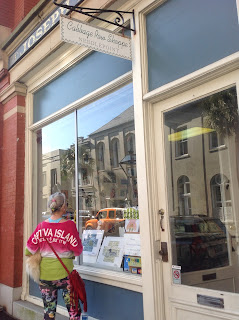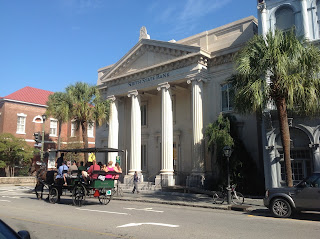Sunday, August 23:
Our drive today from Wilmington to Charleston, South Carolina was around 185 miles down Hwy 17. While our road was almost all a four lane divided highway, the drive was still relatively slow as much of the drive was through towns and cities including Myrtle Beach and we were constantly slowed by 45 mph or slower speed limits, traffic lights, and stop signs. That said, we arrived by 12:30 pm after five hours of driving and for the most part the drive was easy and most of the scenery was pretty. The only really crowded roads did not occur until we reached and passed through Charleston. Our RV park, the Oak Plantation Campgrounds, is around eight miles south of Charleston. Perhaps the biggest surprise of our drive was passing over the Arthur Ravenel Jr. Bridge over the Cooper River coming into Charleston. This bridge was constructed only ten years ago and it still looks brand new and is quite stunning in appearance. I hope that this shows in this photo.
Our campground was highly rated and we can understand why as our site was paved with concrete, surrounded with well maintained grass, and covered with a nice shade tree. The only problem is despite their promises when we booked the reservation, the WiFi did not work in the back of the park where we were placed. I am currently typing this Blog while sitting at a desk in the campground Office/Campstore. We were somewhat surprised to see that the campground was only around 25% occupied but then considering the high summer temperatures (in the low 90s today), and the fact that children have already returned to school here in the southeast, we understand why this highly rated facility is currently being underutilized.
Because of the awful traffic we decided not to drive this afternoon into the historical district of Charleston. We had visited Charleston many years ago and we know that the old homes and buildings inside the historic district are incredible to view, nevertheless we thought it best to wait until the traffic is lighter tomorrow morning before we make the trip.
Monday, August 24th:
Only the few very wealthy people of Charleston live in the downtown historic district and the rest of the working class folks must live out by our campground, for on Monday morning at 7:45 am when we headed back into the city, the road was again bumper to bumper traffic. Frankly this is an awful way to start a trip to visit one of our country's most beautiful cities. Furthermore when we finally did make our way down to the southern point of this peninsular shaped city where the Ashley and Cooper Rivers join, we spent almost a half hour trying to find a place to park. All of the parking spaces on the side streets are reserved for residents and the rest of the spaces were mostly occupied. We finally found a spot on Murray Blvd up the street from the White Point Garden, also called Battery Park. It seems that in the past cannons were placed in this area of the city to defend against the occasional enemy warship or pirate attacks. The park is really quite lovely consisting mostly of huge old oak trees and a few statutes but considering that the park is surrounded on two sides by multimillion dollar mansions and water on the other two sides, the park land itself is literally priceless in value.
Kathy, Cabo, and I must have walked at least a mile or more along Murray Street and East Battery Street as well as down several of the side streets looking at some of the most incredibly beautiful and historical homes found anywhere in our country. While Savannah and some of the other older cities that we have visited have very fine old historic homes, the sheer size of the homes in the most southern section of the Charleston Peninsula, outclass if nothing else, the value of any of the homes we visited in these other cities. For example, the mansion shown in this photo to the right is for sale for $7.2 million and it is only a 7,500 square foot home with 7-bedrooms and 6-baths. I suspect that this is the price range of most of the homes in this section of Charleston.
While probably none of the current homes in Charleston date back as far as the founding of the city back in 1663, the sheer quantity of old homes, many built as far back as the late 1700s, is so much larger than we found in Wilmington and even Savannah. Many of the homes especially in the most southern section of the historic district particularly along the river are just elegant mansions almost to the point where their shear size and value detract from the fun of walking by the homes. Frankly, both Kathy and I enjoyed walking by the historical homes both in Savannah and Wilmington more so than we did the mansions of Charleston. Perhaps it is because we had to walk on the other side of the street just to see the entire home plus there were few shade trees in front of homes of this immense size. Just look at the size of these mansions in the photograph. Awesome. They were undoubtedly originally built by wealthy plantation owners many of whom might very well have lost everything following the Civil War.
I took at least a dozen photos of differnt Charleston mansions and it was almost impossible to select only three to include in this blog; they were all classical and all of them if they were sold today would bring in multi-millions. We particularly liked this old pink mansion. One thing that we did miss in our tour was the historical markers that tell us something about the history of each of the homes. Perhaps when you own a $10 million dollar home you have the right to deny the use of an historical marker right in front of your home.
After walking through the residential neighborhoods near and around Battery Park, Kathy and I decided to drive over and check out Charleston's downtown area, assuming that we would find a place to park. As it turned out all the parking spaces were metered and there were plenty of available spots. We concluded that the wealthy residents prefer not to pay 25-cents for 20 minutes of parking. We loaded the meter with quarters and set out walking. Our first stop was at the Old Exchange and Provost Dungeon building also known as the Custom House where two costumed ladies who were acting as museum docents greeted Cabo with enthusiasm. The Custom House, now a museum, was built between 1767 and 1771. This old building was used in the past as a customhouse, mercantile exchange, and during the Revolutionary War as a British prison and barracks.
Most of the downtown area consisted of small specialty shops (sorry no Walmart or large grocery stores) which is undoubtedly a reflection of the small size of the various businesses that occupied these buildings during the late 1700s and 1800s. This needlepoint shop that attracted Kathy's attention is pretty typical of the types of businesses in the historical district. We were both shocked to see that their needlepoint patterns were being offered for sale for $100 each. Must be another reflection of this wealthy neighborhood.
Even on this Monday morning horse-drawn carriages carrying tourists were a common sight within Charleston's historic district. The South State Bank building in the background of the photograph of the horse-drawn carriage is relatively new for a city like Charleston: it was first opened in 1934 and is still in operation today. I would never have guessed that this bank building is almost brand new for a city the age of Charleston.
Besides there being a lot of old bank buildings in the downtown area, it is not surprising to also find many old churches. One of our favorites was the St. Michaels Episcopal Church which is the oldest surviving church in Charleston built between 1752 and 1761. What would be very unusual to find in our more modern churchyards, is that the entire "backyard" of St. Michaels is an old cemetery where incidentally, two signers of the Constitution of the United States are buried. Unfortunately we were unable to go into the church although we did walk through the old cemetery. Many of the gravestones were worn smooth with age. Everything around the church was being beautifully maintained.
As we headed back to find our car, we found ourselves walking down another old and narrow street lined on both sides with old townhouses. Here we found a 3-story townhouse for sale that Kathy showed quite a liking to despite its rather shabby exterior appearance. The width of the townhouse appeared to be only around 20 feet wide. Perhaps, Kathy remarked, if the price of the townhouse is affordable, perhaps we can discuss a purchase. Later when we returned to our campsite I had a chance to look at this affordable townhouse and discovered that this 2,941 sqft, 3 beds, 3 baths townhouse built back in 1803 was listed for only $1,899,000 and they were calling it a "Rowhouse." This is definitely not a cheap part of the city in which to purchase a home. Incidentally if you want to look up this "rowhouse" online, just type in the address 24 Queen Street, Charleston, SC on Zillow.com. My sales commission is only 2%.
We finally found our car after a few wrong turns (of course we were without street maps) only to find that our time on the parking meter had expired. Fortunately no ticket. We made our way back to the campsite where we spent the rest of the afternoon relaxing and planning what we are going to do tomorrow. We decided that it is probably time to head home. I made reservations for one night only in Jacksonville. After that, we may just make the drive back to Estero, Florida to enjoy the remainder of the summer. We will see what happens.











Nice article and beautiful pictures...thanks for sharing
ReplyDeletetravel write for us
Thank you.
ReplyDelete